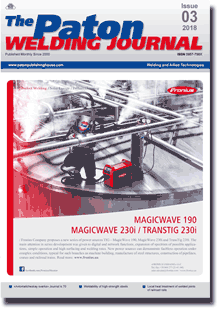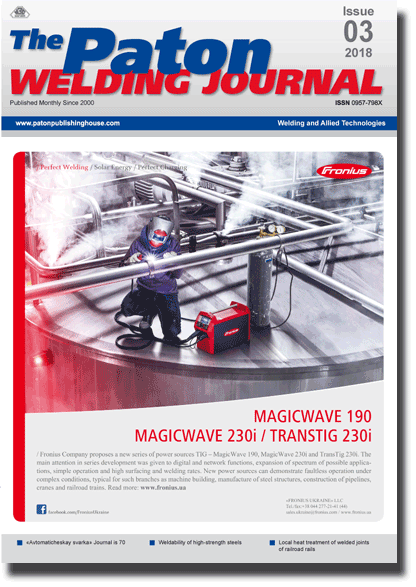| 2018 №03 (02) |
DOI of Article 10.15407/tpwj2018.03.03 |
2018 №03 (04) |

The Paton Welding Journal, 2018, #3, 16-19 pages
Fatigue resistance of steel welded joints of different strength with steady residual stresses
V.A. Degtyarev
G.S. Pisarenko Institute for Problems of Strength of the NAS of Ukraine 2 Timiryazevskaya Str., 01014, Kyiv, Ukraine. E-mail: ips@ipp.kiev.ua
Abstract
A work proposes a comparative analysis of the diagrams of cycle limiting stresses in welded joints of low-carbon and low-alloy steels of different strength under condition that they have the same level of steady residual stresses. By the example of testing of St3sp (killed), 09G2S and 14KhMNDFR steel butt welded joints it is shown that the welded joints with larger mechanical properties have higher endurance limits in all investigated range of change of the limiting steady residual stresses. It was found that the welded joints of stronger steels have also higher values of endurance limit at the same relative value of cycle average stress. They rise more intensively with increase of the relative values of cycle average stress. 10 Ref., 2 Tables, 5 Figures.
Keywords: welded joint, cycle stress amplitude, cycle average stress, yield limit, steady residual stress, endurance limit, diagram of cycle limiting stresses
Received: 23.01.18
Published: 12.04.18
References
- Knysh, V.V. Solovej, S.A. (2017) Improvement of service life of welded joints with fatigue damages. Kiev, KPI [in Russian].
- (2014) Steel structures. Design standards DBN V.2.6-198 [in Russian].
- Degtyarev, V.A. (2016) Prediction of limiting amplitudes of cycle stresses of welded joints with steady residual stresses. The Paton Welding J., 10, 14–19. https://doi.org/10.15407/tpwj2016.10.03
- Trufyakov, V.I. (1973) Fatigue of welded joints. Kiev, Naukova Dumka [in Russian].
- Troshchenko, V.T., Tsybanev, G.V., Gryaznov, B.A., Nalimov, Yu.S. (2009) Strength of materials and structures. Fatigue of metals. Influence of surface state and contact interaction. Kiev, IPS, Vol. 2 [in Russian].
- Krizhanovsky, V.I., Kasperskaya, V.V., Pogrebnyak, A.D. (2008) Evaluation of limit state of structural steels under asymmetric multicycle loading by tension, compression, bending and torsion. Problemy Prochnosti, 5, 81–88 [in Russian].
- Golub, V.P. (2001) Experimental analysis of high-temperature creep, fatigue and damage. 1: Analysis methods. Appl. Mech., 37, 4, 425–455.
- Pavlov, V.F., Kirpichyov, V.A., Ivanov, V.B. (2008) Residual stresses and fatigue resistance of strengthened parts with stress concentrators. Samara, OOO Izd-vo SNTs [in Russian].
- Myunze, V.Kh. (1968) Fatigue strength of welded steel structures. Moscow, Mashinostroenie [in Russian].
- Oding, I.L. (1962) Acceptable stresses in machine-building and cyclic strength of metals. Moscow, Mashgiz [in Russian].
Suggested Citation
V.A. Degtyarev (2018) Fatigue resistance of steel welded joints of different strength with steady residual stresses. The Paton Welding J., 03, 16-19.The cost of subscription/purchase order journals or individual articles
| Journal/Currency | Annual Set | 1 issue printed |
1 issue |
one article |
| TPWJ/USD | 384 $ | 32 $ | 26 $ | 13 $ |
| TPWJ/EUR | 348 € | 29 € | 24 € | 12 € |
| TPWJ/UAH | 7200 UAH | 600 UAH | 600 UAH | 280 UAH |
| AS/UAH | 1800 UAH | 300 UAH | 300 UAH | 150 UAH |
| AS/USD | 192 $ | 32 $ | 26 $ | 13 $ |
| AS/EUR | 180 € | 30 € | 25 € | 12 € |
| SEM/UAH | 1200 UAH | 300 UAH | 300 UAH | 150 UAH |
| SEM/USD | 128 $ | 32 $ | 26 $ | 13 $ |
| SEM/EUR | 120 € | 30 € | 25 € | 12 € |
| TDNK/UAH | 1200 UAH | 300 UAH | 300 UAH | 150 UAH |
| TDNK/USD | 128 $ | 32 $ | 26 $ | 13 $ |
| TDNK/EUR | 120 € | 30 € | 25 € | 15 € |
AS = «Automatic Welding» - 6 issues per year;
TPWJ = «PATON WELDING JOURNAL» - 12 issues per year;
SEM = «Electrometallurgy Today» - 4 issues per year;
TDNK = «Technical Diagnostics and Non-Destructive Testing» - 4 issues per year.


